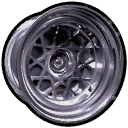Welcome to my drift jumping guide… this entire thing may sound complicated, but that's just because I'm trying to explain every little detail of the game. Most of these techniques are actually pretty easy to pull off with some practice. So here goes... learn these techniques in order.
Brake Drifting
This will help you take turns sharper and give you some extra speed to boost.
To brake drift, start drifting before you get to the turn, then tap/hold the brake around the apex of the turn to take it tightly. Boost immediately after using the brake.
Brake drifting should give you 230+ mph if you’re not being handicapped.
Introduction to Drift Jumping
To drift jump, you need to boost in the air and drift upon landing. There are two ways to do this:
-
Either drift before you go off the ramp and maintain that drift through the air (my preferred method), or…
-
Drift when you land by tapping the brake when your car makes contact with the ground (alternate method).
More air usually means more speed.
Both methods work nearly the same way, but drifting before you jump (Method 1) gives you slightly higher speeds on some ramps. Also, harrier bumps and jumps can only be done if you drift before getting to the jump.
Method 1 also leaves more room for error… if you hit the wall while in the air or do something else that screws up your drift, you can just tap the brake as you land (Method 2) to get the speed that you would’ve lost otherwise.
Method 2 is useful for large ramps and ramps surrounded with obstacles since it’s easier to dodge obstacles when you're NOT drifting in midair.
Brake Jumping
Short Version: Brake enough before each jump so that when you land, your car is going 209 mph.
Long Version: To get SAVAGE speed with drift jumping, you need to SLOW DOWN before you get to each jump. This may sound counterintuitive, but it works. To do this, you need to brake jump.
Using Method 1, you should be already be drifting before each jump. For a brake jump, hold the brake while doing your normal drift (a sort of brake drift). As soon as you lift off the ground, let go of the brake and slam on the boost.
[ If you're using the alternate technique you should do pretty much the same thing. Just hold the brake before the jump without drifting. For some reason, braking without drifting, as done using this technique, seems to cause your car to dive into the ground more quickly upon leaving the ramp... weird stuff. ]
To get optimal speeds, you have to brake just enough BEFORE the jump so that, right when you land, your car is just barely hitting 209 mph. It's not possible to hit exactly 209 every time, so just aim for the 205-208 range, which will give you nearly the same speeds. Letting your car go over 209 mph will lower your speed quite a bit, so if you're going to misjudge your braking a bit, it's better for you to brake a little too much than too little.
And try to do all your braking just before you go off the ramp, and release the brake as your car lifts off the ground - if you slow down even a little bit earlier than you have to, you will waste a little bit of time actually driving up to the jump itself.
Note that on some steeper ramps (especially if you’re being handicapped and are going pretty slow already), you shouldn’t brake going off the jump – either release the gas as you go up the ramp or just take the ramp normally.
Harrier Bumps
The harrier bump lets you get extra air off small bumps and dips in the track, giving you some extra drift jump speed. Works only with Method 1.
Short Version: Start drifting before you get to the bump/dip. Hit the brake just before you reach the bump/dip to lift off the ground, then boost and do the usual drift jumping crap to get speed.
Long Version: You have to do two things to get a harrier bump to work well:
-
Tap the brake to start a drift up before you get to the bump, and…
-
While still drifting, hit the brake as you come up to the bump to get extra air.
The idea behind brake jumping works here too – you want to hit the brake for a reasonable amount of time as you reach the bump so that you get good speed upon landing and not just good air. It’s possible to do the craziest harrier bump ever and still get really crappy speeds.It takes some practice to get used to, but once you learn how to do it, you can even use the technique on normal jumps and ramps, as explained in Harrier Jumps…
Harrier Jumps
Harrier jumping is just using the harrier bump technique on jumps and ramps… this is what you’re going to want to use for a ton of the jumps in the game, so get this down.
-
Tap the brake to start drifting before you get to the ramp…
-
As you approach the ramp, while still holding the same drift, hold the brake again. In the process, you should both slow your car down (brake jumping) and get some extra lift (harrier jumping).
The entire process should be one huge drift, all starting from that first tap of the brakes.If you want to see if you’re doing it right, Angel Valley is a great track to test it on. On Angel Valley F, try using it as you hit the first of the two drops that drop you into the sewer. Since the alleyway is narrow, it’ll be hard to both start a drift before getting to the jump and then holding the brake again to slow down as you reach the jump – this is one jump where you have to slow down a lot to land at 209 mph. You’ll get around 250 mph if you do everything right. Angel Valley R also has a few ramps that are good for harrier jumping. The ramp leading out of the tunnel halfway through the track should give you 260 mph if you do it perfectly.
Drift Everywhere!
Even if you’re great at getting crazy speeds, you’re not going to be fast unless you learn how to maintain your speed. The main thing to know is that normal turning – that is, without drifting – will lower your speed no matter what. This means that most of the time you should be drifting when you want to turn, even if it’s just a slight correction to the direction of your car that you want to make. Every time you forget to drift, you will slow down a bit, and even 2-3 mph off your speedometer is going to hurt if you consistently make that mistake.
You should also sometimes drift on straights. There are lots of little bumps on straights that are barely noticeable but will help you out if you manage to drift over them. Drifting also gives you some extra boost.
Original link: https://web.archive.org/web/20210117143804/https://burnoutaholics.com/?q=node%2F330







